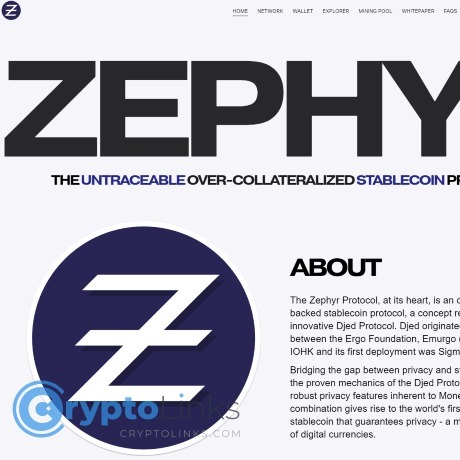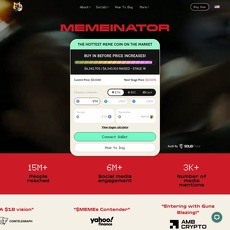Zephyr Protocol Review
Zephyr Protocol
zephyrprotocol.com
If your website is on the scam list and you think that you are not a scammer, contact us. After you provide us with all the proof that you are in Crypto World with good intentions, we will delist you. Usually, you get in this category because you are hiding your team, you have a bad reputation(you are tricking, deceiving, scamming people), and you haven't got a written project whitepaper or is a shitty one....
Their Official site text:
Zephyr Protocol
The Untraceable Over-Collateralized Stablecoin
June 5, 2023
Abstract. This paper presents an exploration of the Zephyr Protocol, a
privacy-oriented cryptographic coin that combines the novel algorithmic,
reserve backed approach of the Djed stablecoin framework with the
privacy enhancing features of Monero. Serving as an autonomous
financial institution, Zephyr Protocol facilitates the buying and selling of
stablecoins within a predetermined price range tied to a target price. The
Zephyr Protocol relies on a reserve composed of a volatile
cryptocurrency, enabling the minting and redeeming of stablecoins by
users who wish to move in and out of stable value, while also storing the
revenue generated from stablecoin transactions as profit for the reserve
backers.
1
Introduction
Zephyr is a digital currency that combines the principles of privacy and stability. Grounded firmly
on the proven Minimal Djed protocol, in combination with the powerful privacy preserving
features of Monero, Zephyr introduces the first private, reserve backed stablecoin system. The
Djed protocol, which draws inspiration from AgeUSD, is a collaborative brainchild of Emurgo,
IOHK, and the Ergo Foundation and has been successfully implemented in a number of crypto
projects with great success.
With Zephyr, users can mint or redeem stable (ZephUSD) and reserve (ZephRSV) coins in
exchange for the base coin (ZEPH). The price for stable coins is determined by a pricing oracle
and contains both a spot and moving average (MA) price. The price for reserve coins is
determined using a formula based on the current reserve data.
When minting new stable/reserve coins the base coins that are exchanged (+fee) get added to
the Zephyr reserve. This reserve is the collateral backing for the stablecoin holders and is
ensured to be above 400% collateral at all times. In the event that collateralization falls below
400% due to price decrease, new stable coins are unable to be minted, however the reserve
coin price will drop (to a min of P
min
RC) giving incentive for users to buy reserve coins at a
reduced rate.
Reserve coin holders are entitled to redeem their reserve coins for the amount of equity in the
reserve based on their proportion of reserve coin holdings. This means that as stable coins are
minted and redeemed, the accumulated fees will build up in the reserve as profit for holders of
the reserve coin. There is a maximum reserve ratio of 800% that halts the minting of new
reserve coins to prevent dilution for the existing reserve coin holders.
An important part of Zephyr’s design that differs from DJED, is the introduction of two reserve
ratios. One for the current spot price and one for the current moving average price. This is done
as DJED only uses one oracle price however Zephyr has opted to use 2 in order to eliminate
any potential advantages gained via price manipulation. The details of the reserve calculations
are described later in this paper.
2
Technical Specifications
Total Supply: 18.4 Million (+ tail emission 0.6 ZEPH p/block)
Block Time: 120 seconds
Assets:
● ZEPH (Base Currency)
● ZephUSD (USD Stablecoin)
● ZephRSV (Reserve Currency)
Mining Algorithm: RandomX proof-of-work (PoW) optimized for general-purpose CPUs to
promote decentralization and egalitarian mining.
Emission Curve: Zephyr has been designed with a slightly slower emission curve compared to
Monero. This design choice is aimed at rewarding early adopters by reducing their dilution over
time. By slowing the initial emission, the potential inflationary impact on the price of ZEPH is
lessened, benefitting the stability of the algorithmic stablecoin system.
Assets
Base coin (ZEPH)
At the core of the Zephyr Protocol lies the base currency - ZEPH. ZEPH forms the primary
medium of exchange within the Zephyr ecosystem, serving as the fundamental layer linking the
stablecoin (ZephUSD) and the reserve coin (ZephRSV).
ZEPH, being the native currency, has an essential role in ensuring the smooth operation of the
Zephyr Protocol. Users who wish to enter the stablecoin system can do so by depositing ZEPH
into the Protocol and minting ZephUSD in return. Here, the value of ZEPH serves as the
underlying collateral, giving ZephUSD its stable character.
The supply of ZEPH is not affected from the minting and redeeming process of the stablecoin
and reserve coin. ZEPH can only be added or removed from the reserve. The supply of ZEPH
can never increase during these operations due to the reserve's function, shielding ZEPH
holders from runaway inflation.
The Zephyr Protocol has been designed with a slightly slower emission curve compared to
Monero. This design choice aims to reward early adopters by reducing their dilution over time.
The slower initial emission mitigates the potential inflationary impact on ZEPH's price,
enhancing the stability of the entire algorithmic stablecoin system. By carefully managing
ZEPH's emission, Zephyr ensures the long-term sustainability and health of the ecosystem
while protecting the interests of all stakeholders.
In essence, ZEPH serves as the lynchpin of the Zephyr Protocol, acting as the primary medium
of exchange and the fundamental value layer.
3
Stable coin (ZephUSD)
Zephyr Protocol introduces ZephUSD, a truly unique stablecoin that combines the stability,
efficiency, and privacy in a way not seen before in the cryptocurrency landscape. This
stablecoin, while maintaining a stable value in relation to the US dollar, also inherits the powerful
privacy features of Monero, making it a private stablecoin. This special characteristic sets
ZephUSD apart in the crypto market by providing a level of anonymity similar to cash
transactions.
This privacy-oriented stablecoin is over-collateralized by ZEPH, the base currency, and its price
is determined by a pricing oracle that incorporates both spot and moving average (MA) prices.
The system smoothly adjusts to market conditions, ensuring the stability of ZephUSD. Users
can mint or redeem ZephUSD in exchange for ZEPH based on the oracle's current price.
Unlike traditional stablecoins that require central authorities to maintain their peg to real-world
assets, ZephUSD operates in a decentralized manner, thereby eliminating the potential risks
associated with centralized control. This decentralization, combined with advanced privacy
features, enables users to transact freely and anonymously without the worry of volatility or
surveillance.
In essence, ZephUSD is not just a stablecoin, it is a novel fusion of stability and privacy,
reshaping the idea of anonymous cash transactions for the digital age. It does not aim to
replace the traditional systems but strives to refine them, making them more suited for the
needs of today's world. With ZephUSD, users can maintain their value stability while ensuring
their transactions remain private and secure, in a system that is resistant to central control or
manipulation.
Reserve coin (ZephRSV)
The Zephyr Protocol has introduced the concept of a reserve coin, termed ZephRSV. Holders of
this reserve coin function as reserve providers, depositing ZEPH into the Protocol to mint
ZephRSV. The pricing structure for these reserve coins relies on a formula rooted in the current
state of the reserve, thereby creating a dynamic system responsive to market fluctuations.
ZephRSV holders are strategically positioned to benefit when the base coin, ZEPH, appreciates
in value, offering a form of leveraged exposure to ZEPH's potential growth. This potential profit
isn't just limited to ZEPH's price appreciation, but also includes the accruing of transaction fees,
which add to the reserve as more ZephUSD coins are minted and redeemed. This process not
only amplifies the profit potential for ZephRSV holders but also contributes to the stability of the
ZephUSD, as these transaction fees increase the value of the reserve, thereby reinforcing the
over-collateralization of ZephUSD.
Yet, this process doesn't carry the risk of diluting the value held by current ZephRSV holders.
The Protocol maintains a maximum reserve ratio of 800%, ensuring that the minting of new
4
reserve coins is halted so that the value held by existing ZephRSV holders is not diluted. This
mechanism underscores the balance that the Zephyr Protocol strikes between enabling growth
and maintaining stability.
In addition to these benefits, ZephRSV holders have the power to redeem their coins based on
their share in the reserve's equity. This gives them a significant degree of flexibility and control,
reinforcing the decentralized ethos of the Zephyr Protocol.
ZephRSV presents an enticing blend of profit-making and stability-supporting features, offering
its holders a distinctive position in the Zephyr Protocol. It's not just a reserve coin but an
opportunity to be part of a robust and dynamic system that aims to redefine the intersection of
privacy, stability, and decentralization in the cryptocurrency world.
Privacy and Anonymity
Zephyr inherits all of Monero’s robust privacy-centric features, fortifying transactional privacy
and confidentiality.
● Ring Signatures: Ring signatures obfuscate the origin of transactions by mixing a
user's account keys with public keys from the blockchain. This cryptographic
methodology ensures the user's identity remains concealed, making it impossible to
isolate and trace transactions back to the user.
● Bulletproofs: Bulletproofs are a form of non-interactive zero-knowledge proof that
Monero uses to obscure transaction amounts. While protecting privacy, Bulletproofs
also reduce the size of cryptographic proofs, thereby optimizing blockchain efficiency by
conserving space and improving transaction speed.
In addition to these foundational privacy features, Zephyr advances this functionality by
supporting multiple, private, and anonymous assets on a single chain: ZephUSD (stable coin)
and ZephRSV (reserve coin).
By maintaining the integrity of the privacy and security inherent to the Monero architecture,
Zephyr ensures that users of ZephUSD and ZephRSV can transact with the assurance of
complete anonymity and confidentiality.
Supply Transparency
Although the amounts in transactions are hidden, we record the amount
minted/redeemed/added to reserve during conversion transactions to keep a running tally for
5
consensus and so each block can calculate and verify all of the reserve data. Privacy is
preserved even when revealing the amount in a conversion as it is not known which outputs
made up the inputs for that transaction, nor is it possible to know for an outside observer which
of the outputs contain the newly minted amount or the address that controls it.
Pricing Oracle
A blockchain oracle is a system that retrieves and verifies real-world data and supplies this
information to the blockchain. It acts as a bridge between the deterministic world of blockchain
and the non-deterministic world outside, providing the necessary data for smart contracts to
execute based on real-world events and conditions.
The pricing oracle in Zephyr operates as a key component in maintaining the stability of the
system. It retrieves current market data, processes it, and provides this information to the
network to use in conversion transactions.
Oracle v1
In the initial version of Zephyr's oracle, when a new block is mined, the miner makes a call to
the oracle to populate a pricing record. The oracle's response is signed, and this signature is
verified when the mined block is added to the chain. Other nodes in the network perform this
same verification, ensuring the pricing record matches as a part of network consensus. This
helps maintain the integrity and accuracy of the data provided by the oracle.
Anti-Price Manipulation Measures
Price manipulation poses a significant threat to the stability of any system tied to market data. In
the case of Zephyr, it is essential to counter such potential threats. Here is a manipulation
scenario without any counter-measures:
1. Zeph is priced at $1.
2. An actor mints 100 stablecoins for 100 ZEPH (mint_stable).
3. The actor then dumps the price to 50 cents.
4. The spot price drops to 50 cents and is included in the next block.
5. The actor uses redeem_stable on the 100 stablecoins to get 200 ZEPH from the
reserve (200 ZEPH @ 50c = $100).
6. The actor drives the price back up to $1 and repeats the process.
To prevent such manipulation, Zephyr employs a mechanism that uses the worst price between
the spot and the moving average (MA) for both pricing assets and calculating the reserve state.
At all times the reserve rules must be satisfied for both the spot and moving average pricing of
the reserve assets.
6
Oracle v2 and Future Directions
While Oracle v1 offers a robust solution for price verification and network consensus, the plan is
to further improve this system with Oracle v2. Potential updates may include measures to
further enhance the robustness of price data verification, minimize the potential for
manipulation, and improve the overall security, decentralization, and efficiency of the oracle.
More research is underway to determine the best approaches and methodologies for
implementing these enhancements. The precise specifications for Oracle v2 will be shared once
they are finalized.
Basic Scenarios
1: When the Base Currency (ZEPH) Price Increases
Consider Alice, a user with 100 ZEPH, looking for value stability. On the other side, we have
Bob, who owns 200 ZEPH and wants to increase his holdings, betting on ZEPH’s future value.
Bob becomes a Reserve Provider, depositing his 200 ZEPH into the Zephyr Protocol and
minting reserve coins. These coins are redeemable for underlying ZEPH reserves at any point,
as long as the reserves are above the minimum reserve ratio.
Alice, seeking stability, deposits her 100 ZEPH into the Protocol and mints 100 USD stable
coins. Now, the total reserve equals 300 ZEPH. Imagine four weeks pass, and the price of
ZEPH increases by 10%.
Alice, excited about the recent price spike, decides to exit stability. She redeems her 100 USD
stable coins and withdraws 100 USD worth of ZEPH. With ZEPH price at $1.10, her stable
coins are redeemed for 90.90 ZEPH, leaving 209.1 ZEPH in the Protocol reserves.
Bob, wishing to secure his profit, redeems his reserve coins for the remaining reserves,
receiving 209.1 ZEPH. Thus, Bob profits 9.1 ZEPH by providing reserves to the Protocol, while
Alice, by minting her stable coins, maintains value stability.
2: When the Base Currency (ZEPH) Price Decreases
Now, let’s look at the scenario where ZEPH’s price drops. Assuming Alice and Bob start with
the same amount of StableCoins/ReserveCoins as in the previous example, after four weeks,
ZEPH’s price decreases by 10%.
Alice decides to exit her StableCoins, redeeming them for 100 USD worth of ZEPH. With ZEPH
price at $0.90, she receives 111.12 ZEPH for her StableCoins, leaving 188.88 ZEPH in the
Protocol reserves.
7
Next, Bob decides to exit his ReserveCoins, receiving the remaining 188.88 ZEPH in reserves.
In this situation, Bob has lost 11.12 ZEPH by providing reserves to the Protocol, while Alice,
through her StableCoins, has maintained value stability in relation to USD.
In essence, the ZephRSV holders take on a leveraged position, betting on the value of ZEPH via
increased adoption. This leverage is fundamental to how ZephRSV holders make a profit.
8
Stablecoin Solutions: A Comparative Analysis
Stablecoins are digital tokens designed to maintain a consistent value relative to an underlying
asset or currency. They play a vital role in offering liquidity to cryptocurrency markets and
provide a buffer against market volatility. When the stormy seas of cryptocurrency markets
appear to churn, investors often seek shelter by moving their assets into stablecoins.
The Central Dilemma
Algorithmic stablecoins face a balancing act: how to best protect the base coin and the
stablecoin simultaneously. These two components are equally critical, and Zephyr Protocol
aims to safeguard both in the most practical manner.
The Unique Proposition of Zephyr
What distinguishes Zephyr is its protocol design, which ensures no additional ZEPH (the base
coin) is ever spontaneously created, safeguarding the stability and value of the network.
Instead, ZEPH's supply grows only through scheduled emission.
Zephyr Protocol
Zephyr sets a conservative minimum reserve ratio of 400%. Consequently, no stablecoin can
be minted when the reserve ratio falls below this threshold. This design ensures that every
ZephUSD (the stablecoin) has backing from an equivalent value of at least 400% in ZEPH. The
protocol incorporates mechanisms and incentives to maintain adequate collateral supporting
the circulating ZephUSD. These include transaction fees on minting and redeeming stablecoins,
which contribute additional ZEPH to the reserve over time. Furthermore, the value of ZephUSD
is tethered to both the spot and moving average prices of ZEPH. Any discrepancy between
these prices reduces the strain on the reserve during mint and redeeming actions. In scenarios
where the reserve ratio drops, users are incentivized to deposit ZEPH in exchange for ZephRSV
(reserve tokens) at a discounted rate, thus bolstering the reserve. In the worst-case scenario,
where reserve ratios fall below 1, the value of ZephUSD corresponds to the actual share in the
reserve. Redeeming actions of ZephUSD at a reduced rate under these conditions serve to
bolster the protocol reserve.as opposed to further damaging the network state.
Limitations
● Capital Efficiency: The mandatory 400% collateral requirement can impact capital
efficiency in the model.
● Catastrophic Events: In extreme situations where the protocol's mechanisms and
incentives are insufficient, the value of ZephUSD may be affected for users needing to
redeem their tokens before additional ZEPH is added to the reserve or the value of
ZEPH recovers.
9
● Growth Impact: The protocol specifies an 800% maximum reserve ratio, potentially
limiting growth. This constraint, however, fosters sustainable growth by controlling the
quantity of circulating ZephUSD, which overall aids in maintaining the peg.
Below we give an explanation of four notable stablecoin solutions that have entered the crypto
space and against which Zephyr compares favorably in regard to economic stability and
privacy.
With the exception of the Haven model, no other existing solutions currently offer a private,
untraceable stablecoin.
Tether (USDT)
Tether (USDT) is one of the most well-known stablecoins, offering a 1:1 ratio with the US dollar,
ostensibly maintained through reserves of real-world fiat currency. Despite its significant usage
and acceptance across a variety of exchanges, Tether has faced ongoing criticism.
Pros:
● Stability: With each token supposedly backed by fiat reserves, Tether offers relative
stability in the volatile crypto marketplace.
● Liquidity: Tether's acceptance across exchanges and high trading volume make it easily
exchangeable and a popular pairing choice for other cryptocurrencies.
● Global Availability: Tether provides an avenue for cross-border transactions, bypassing
the need for traditional banking systems.
Cons:
● Lack of Transparency: Tether has been criticized for inadequate transparency and
auditing of its reserves. Despite its claims of fiat-backed reserves, there's been little
verifiable evidence to confirm these claims.
● Counterparty Risk: Tether operates as a centralized entity. Therefore, users must trust
Tether Limited to honor its commitments, exposing them to the risk of Tether's potential
financial difficulties or regulatory issues.
● Regulatory Concerns: Regulatory scrutiny in the stablecoin market has been on the rise,
with concerns over potential market manipulation, insufficient anti-money laundering
controls, and overall market stability.
● It's also worth noting that Tether's reserve breakdown reveals only approximately 3% is
fiat USD, with a substantial portion being "commercial paper" – essentially, debt loans
to unknown entities. This structure could potentially collapse under a "run" on Tether,
and the chances of a bailout from a state or international body are minimal.
Terra (UST)
The Terra network offers an algorithmic stablecoin, TerraUSD (UST), which is pegged to the
U.S. dollar. The protocol is designed to maintain this peg through a system of minting and
burning of its native coin, Luna.
10
To create UST, Luna tokens are burnt, implying that when Luna's price was high, more UST
could be generated for each Luna token. This system essentially ensured that the value of UST
would remain around $1 by allowing UST and Luna to be interchanged at will, adjusting for
Luna's price.
However, when UST's value began to significantly deviate from its $1 peg, the protocol's
response led to a catastrophic outcome. In an effort to stabilize UST, the protocol significantly
increased the supply of Luna tokens. This increase in supply, however, caused Luna's price to
plummet as a result of hyper-inflation and investors rushing to sell their holdings.
This scenario highlights some critical issues:
● Extreme Volatility: The sudden and extreme depreciation in Luna's value
demonstrated the risk of volatile and severe price movements in the system. Luna lost
about 98% of its market value overnight, falling close to $0.
● Instability: The algorithmic model, intended to keep UST's value around $1, failed
under stress, leading to a loss of its peg to the U.S. dollar.
● Rush to Exit: When UST lost its peg and Luna's value started to crash, a rush to exit
ensued as investors sought to minimize their losses. This rush further exacerbated the
downward pressure on Luna's price.
● Uncontrollable Inflation: The protocol's response mechanism caused a vast increase
in Luna's supply, leading to rampant inflation that further devalued the token.
Zephyr Protocol, based on the Djed/AgeUSD model, does not face these issues due to the
built-in stability mechanism and a fixed supply of its base coin, ZEPH.
Haven (XHV)
Haven Protocol offers its stablecoin (xUSD), backed by its native cryptocurrency (XHV), but the
implementation has faced some challenges. Initially, the technical design of Haven ensured that
1 xUSD was equal to 1 USD worth of Haven at any time. While technically effective, this model
did not protect the value of the base currency, XHV.
● Unlimited Minting Mechanism: By design, the supply of the stablecoin and XHV is
limitless and isn't tied to the underlying network value. This mismatch has led to an
imbalance where the amount of xUSD in circulation today exceeds Haven's market cap,
a discrepancy that has grown over time.
● Security Breaches: Haven has suffered multiple security breaches, leading to
unauthorized xUSD minting.
● Volatility Risk: The protocol's design is set to protect the stablecoin's value at any
cost. However, this can be detrimental to the base currency, potentially causing a drop
in confidence and leading to a slow death or "death spiral."
11
● VBS: The advent of Vault Backed Securities (VBS) addressed some of these issues but
at the cost of xUSD’s peg. It introduced a need for long-term collateral locking and thus
introduced an opportunity cost for users limiting adoption. Any attempt to ease VBS
could result in more xUSD being redeemed for XHV, potentially decreasing XHV's price
and leading to a similar problem. VBS in its current state has also made it impractical to
arbitrage xUSD on exchanges to help repeg.
● Non-inflationary Peg: Haven offers a BTC xAsset, allowing users to switch between
xUSD and xBTC and mint more xUSD when trades are favorable. This process does not
involve any buying or subsequent burning of XHV. However, even under optimal
conditions, any increase in BTC's price would lead to base coin holders bearing the
cost of these gains. This highlights the importance of pegging to an inflationary asset
like fiat currency for a stablecoin protocol. The inflation inherent in such pegs
theoretically eases pressure on the supporting network.
MakerDAO (DAI)
MakerDAO is a decentralized autonomous organization on the Ethereum blockchain, which
manages and controls the DAI stablecoin. It's one of the oldest and most well-known DeFi
projects in the cryptocurrency space.
The DAI stablecoin is soft-pegged to the U.S. dollar and is backed by collateralized debt
positions (CDPs), now referred to as Vaults in the Maker system. Users can deposit Ether or
other approved tokens into a Vault and generate DAI against this collateral. The
collateral-to-debt ratio is always maintained above a specific minimum to ensure the system's
solvency.
If the value of the collateral falls below this threshold, the Vault is automatically liquidated, with
the collateral being sold off to cover the debt and maintain DAI's stability. The system also
includes a governance token (MKR) used for voting on system parameters and decisions.
Zephyr Protocol, based on the Djed model, follows a different approach. Instead of using
CDPs/Vaults, Zephyr Protocol maintains stability through an in-protocol reserve. This reserve,
consisting of the native coin (ZEPH), is used to back the issuance of the stablecoin and ensure
its peg to the U.S. dollar with minimum reserve requirements of 400%.
In conclusion, while each stablecoin solution has its unique features and advantages, they all
carry significant risks and drawbacks. Zephyr Protocol, with its emphasis on protecting the
value of the base currency and stablecoin, presents a promising alternative in this space.
12
Zephyr Symbol Definitions
Symbol Definition
spot Base coin Spot Price
MA Base coin Moving Average Price
P
spot
SC Stable coin spot price
P
MA
SC Stable coin MA price
P
spot
RC Reserve coin spot price
P
MA
RC Reserve coin MA price
PSC Stable coin Price
PRC Reserve coin Price
P
min
RC Minimum Price of Reserve Coin













